Travels and Stories
by Michael Frye | Jul 14, 2024 | Travels and Stories
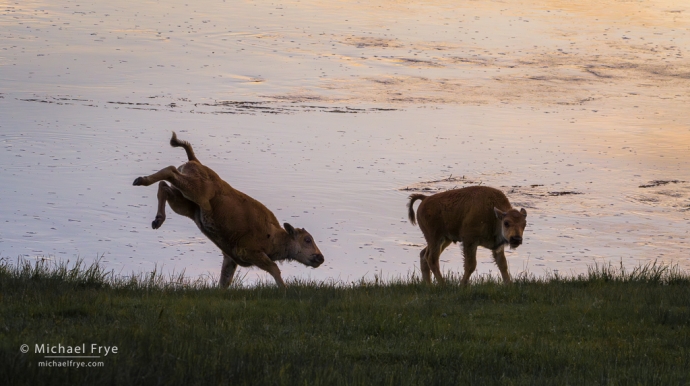
Bison calf kicking up its heels, Yellowstone NP, Wyoming
After our visit to the Tetons, Claudia and I spent a couple of days in Yellowstone before heading home. Since we were only there for two days, we didn’t see the variety of animals we saw in the Tetons, but did get to watch a large bison herd with numerous young calves.
These calves (often called “red dogs” because of their reddish fur) were endlessly entertaining – chasing each other, butting heads, kicking up their heels, or zooming around and around in circles to expend excess energy. Here are some photos of those adorable calves, along with one image of a Canada goose family. And I’ve also included a video Claudia made of the frolicking bison.
(more…)
by Michael Frye | Jul 7, 2024 | Travels and Stories
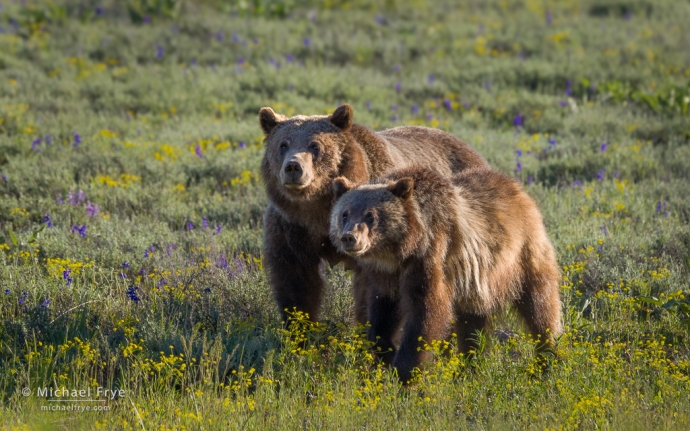
Grizzly 399 and her 18-month-old cub, Grand Teton NP, Wyoming
As I mentioned in my last post, Claudia and I had a great time watching and photographing the wildlife in the Tetons, and during a brief visit to Yellowstone. There’s so much wildlife in these parks, and the animals are relatively easy to see.
For us, the highlight was seeing the famous Grizzly 399 with her yearling cub, and Grizzly 1063 with her triplet cubs of the year – experiences we shared with our friends Charlotte Gibb and Chrissy Donadi, which made it even more fun.
(more…)
by Michael Frye | Jun 29, 2024 | Travels and Stories
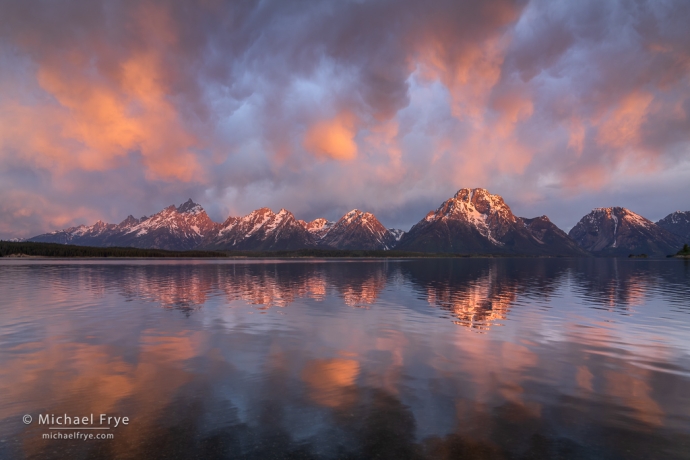
The Teton Range from Jackson Lake at sunrise, Grand Teton NP, Wyoming
Claudia and I had such a great time in the Tetons, before and during the Out of Grand Teton photo conference. The conference went smoothly, as we’ve come to expect from the Out of Chicago folks. We had a great group of participants and fellow instructors, and it was fun hanging out with everyone – teaching, learning, and photographing this beautiful area. Special thanks to my wonderful teaching partner for the conference, Charlotte Gibb, and to Chris Smith, Jennifer Renwick, and all of the Out of Chicago team for making this such a great event!
I actually climbed in the Tetons in the late ’70s, and had been back a few times for photography. But that was awhile ago; in fact it had been more than 20 years since I’d photographed this area. Why did it take me so long to return? I’m not sure, but it was great to be back, and I am sure it won’t take me so long to return again.
(more…)
by Michael Frye | May 19, 2024 | Light and Weather, Travels and Stories, Vision and Creativity
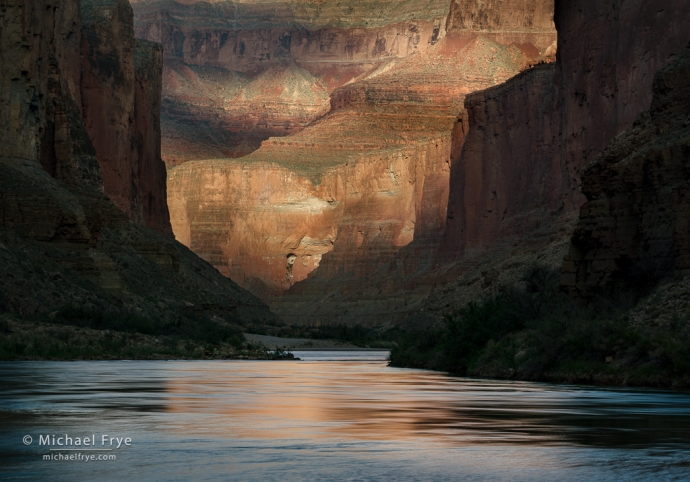
Dappled light above the Colorado River, Grand Canyon NP, Arizona. I used a neutral-density filter (probably seven stops) to slow the shutter speed to three seconds and smooth the water, and had to wait for moments when the wind was calm at the camera position, lest the wind vibrate the camera and blur the photo during the long exposure.
I left the Grand Canyon just a week ago. Once again I co-led a ten-day raft trip down the canyon with my friend Jerry Dodrill for Visionary Wild. And once again it was an amazing trip.
This journey is hard to describe if you haven’t experienced it. It’s more than just a photography trip – although the photography is fantastic. It’s a true wilderness adventure, immersed in the depths of this magnificent canyon for ten days, sleeping under the stars, living by the rhythm of the sun, moon, and river, sharing the experience with a small group of like-minded people. It’s unforgettable.
(more…)
by Michael Frye | Apr 21, 2024 | Travels and Stories
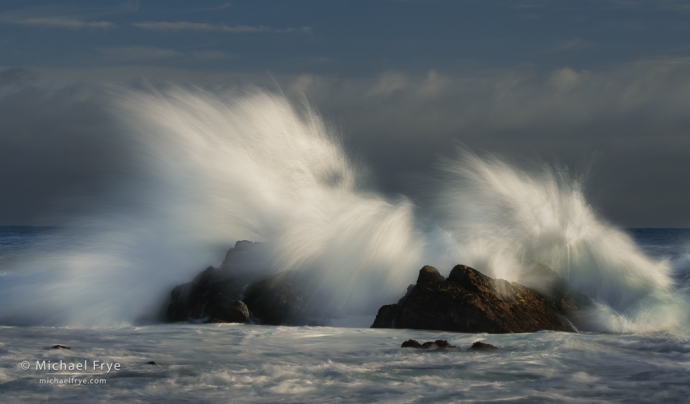
Crashing wave, Monterey Peninsula, California. I used a 1/2 second shutter speed to create some blur and sense of motion, while still preserving some of the shape and texture of the wave.
Because of our eclipse journey I haven’t had a chance to write about the Out of Big Sur conference yet – a big omission, because it was such a fun event! Great people, wonderful co-instructors, great locations, and well-organized by Chris Smith, Chrissy Donadi, and the rest of the Out of Chicago team.
We all had lots of fun photographing the Monterey Peninsula, Point Lobos, and the Big Sur Coast. Though I live fairly close to these areas, I’ve actually spent more time photographing coastal areas farther north near the northern-California redwoods, and along the Oregon Coast. So it was good to get re-acquainted with the Monterey and Big Sur region, and discover some new locations I hadn’t photographed before. It’s such a beautiful area.
(more…)
by Michael Frye | Apr 11, 2024 | Travels and Stories
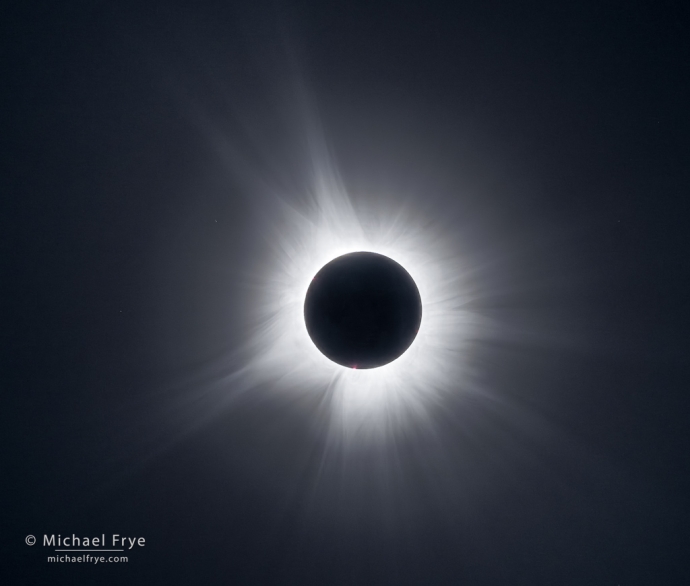
Total solar eclipse, April 8, 2024, northeast Arkansas
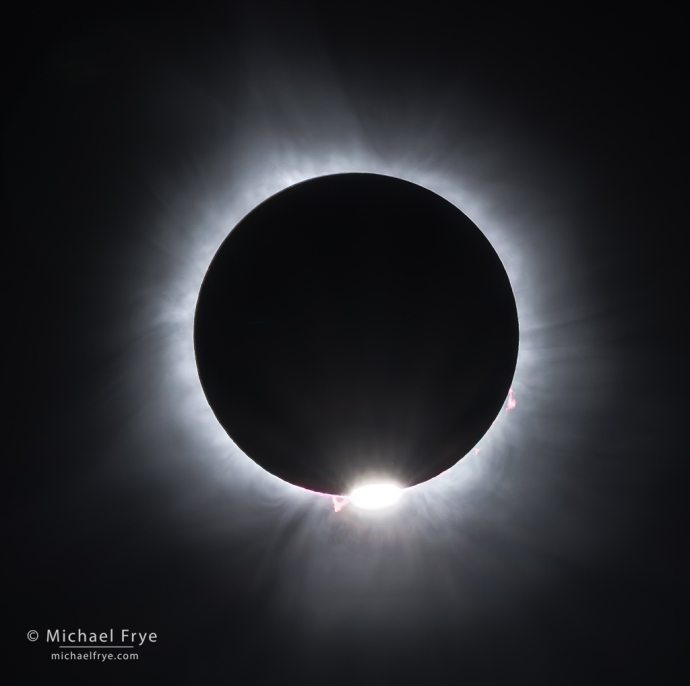
The “diamond ring” and solar flares as the sun emerges from a total solar eclipse, April 8, 2024, northeast Arkansas
I started thinking about the 2024 solar eclipse right after our last one in 2017. Claudia and I, along with our friend Robert Eckhardt, viewed that eclipse from the Sawtooth Mountains in Idaho, and it was such an amazing experience I immediately wanted to do it again.
When I looked at this 2024 eclipse, the best part was the length – four-and-a-half minutes of totality in Mexico and Texas, compared with only a little over two minutes in Idaho in 2017. Two minutes seemed way too short.
(more…)















